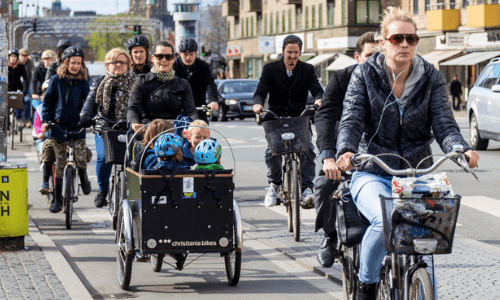
20 Most Bike-Friendly Cities in the World (Find Out Which U.S. City Made the Cut)

A big reason why Copenhagen was given the crown this year is due to its impressive jump in number of bikers. From 2012 and 2014, the number of people commuting by bike increased from 36 percent to 45 percent, whereas commuting by car dropped from 27 percent to 23 percent.
“The Danish capital remains impressively consistent in its investment in cycling as transport and in making efforts to push it to the next level,” the report’s authors wrote.
The election of urban cycling-advocate Morten Kabell as the mayor of the Technical & Environmental Administration in Copenhagen’s Department of Transportation as well as the city’s investment in biking infrastructure (including several new bridges and an elevated bike ramp) has helped increase cycling numbers as well. This is all on top of protected bike lanes, cycling super highways and an ingrained cycling culture. Simply, it’s just easier and faster to bike to work or school because the city is built that way.
Intriguingly, the bike-mad city is also attempting to use bicycle travel times as the baseline for all traffic lights and flow projections, instead of car travel times, the authors noted.
The one major criticism the authors had of Copenhagen’s bike system is its “failed” bike share program. “It’s getting embarrassing,” they wrote. “Put the money into something that actually works.” (Full disclosure: I rode one a year ago and found these hefty electric bikes slow and cumbersome, making it difficult to keep up with Danish pedalers).
The authors of the report pointed out that Minneapolis made its inaugural appearance on the index due to its 189 kilometers of “on-street bikeways” and 147 kilometers of off-street roads. Its “respectable” bike share system was also given kudos (I also rode one of these before and loved it). However, the report recognized that its chilly winters are a big road block and city planners should prioritize snow clearance on the bike infrastructure “above all else.”
“What will help the city, however, is to stop talking about the winter and to focus on getting a massive rise in ridership during the rest of the year,” the authors added.
Even with its harsh winters, when it comes to biking, where there’s a will there’s a way. Check out the clever photo below from Nice Ride Minnesota, the Twin Cities’ nonprofit bike share program.
We’ve had a fun break, now we’re back at it to bring you an even better bike share for 2015! How was your holiday? pic.twitter.com/SxhgqTCSty
— Nice Ride Minnesota (@NiceRideMN) January 5, 2015
YOU MIGHT ALSO LIKE
5 Eco-Cars Taking the Industry by Storm

 233k
233k  41k
41k  Subscribe
Subscribe 